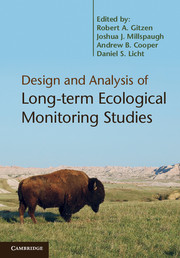Design and Analysis of Long-term Ecological Monitoring Studies
To provide useful and meaningful information, long-term ecological programs need to implement solid and efficient statistical approaches for collecting and analyzing data. This volume provides rigorous guidance on quantitative issues in monitoring, with contributions from world experts in the field. These experts have extensive experience in teaching fundamental and advanced ideas and methods to natural resource managers, scientists, and students. The chapters present a range of tools and approaches, including detailed coverage of variance component estimation and quantitative selection among alternative designs; spatially balanced sampling; sampling strategies integrating design- and model-based approaches; and advanced analytical approaches such as hierarchical and structural equation modelling. Making these tools more accessible to ecologists and other monitoring practitioners across numerous disciplines, this is a valuable resource for any professional whose work deals with ecological monitoring. Supplementary example software code is available online at www.cambridge.org/9780521191548.
- Covers fundamental issues and modern design and analytical approaches, providing a valuable resource for any ecologist whose work deals with ecological monitoring
- Authored by a diverse group of experts practised at teaching fundamental and advanced ideas and methods to natural resource managers, scientists and students
- Many chapters include example software code (longer sections are available online at www.cambridge.org/9780521191548) to help readers apply methods appropriately to their own work
Reviews & endorsements
"… a valuable reference for professionals seeking the latest design and analysis techniques for long-term ecological monitoring."
The Quarterly Review of Biology
"If you do monitoring, you need a copy of this book. It is that good."
Philip M. Dixon, Ecology
Product details
July 2012Hardback
9780521191548
584 pages
254 × 179 × 29 mm
1.3kg
84 b/w illus. 4 colour illus. 42 tables
Available
Table of Contents
- List of contributors
- Foreword
- Preface
- Acknowledgements
- Part I. Overview:
- 1. Ecological monitoring: the heart of the matter Robert A. Gitzen and Joshua J. Millspaugh
- 2. An overview of statistical considerations in long-term monitoring Joel H. Reynolds
- 3. Monitoring (that) matters Douglas H. Johnson
- 4. Maximizing the utility of monitoring to the adaptive management of natural resources William L. Kendall and Clinton T. Moore
- Part II. Survey Design:
- 5. Spatial sampling designs for long-term ecological monitoring Trent McDonald
- 6. Spatially balanced survey designs for natural resources Anthony R. Olsen, Thomas M. Kincaid and Quinn Payton
- 7. The role of monitoring design in detecting trend in long-term ecological monitoring studies N. Scott Urquhart
- 8. Estimating variance components and related parameters when planning long-term monitoring programs John R. Skalski
- 9. Variance components estimation for continuous and discrete data, with emphasis on cross-classified sampling designs Brian R. Gray
- 10. Simulating future uncertainty to guide the selection of survey designs for long-term monitoring Steven L. Garman, E. William Schweiger and Daniel J. Manier
- Part III. Data Analysis:
- 11. Analysis options for estimating status and trends in long-term monitoring Jonathan Bart and Hawthorne L. Beyer
- 12. Analytical options for estimating ecological thresholds - statistical considerations Song S. Qian
- 13. The treatment of missing data in long-term monitoring programs Douglas H. Johnson and Michael B. Soma
- 14. Survey analysis in natural resource monitoring programs with a focus on cumulative distribution functions Thomas M. Kincaid and Anthony R. Olsen
- 15. Structural equation modeling and the analysis of long-term monitoring data James B. Grace, Jon E. Keeley, Darren J. Johnson and Kenneth A. Bollen
- Part IV. Advanced Issues and Applications:
- 16. GRTS and graphs: monitoring natural resources in urban landscapes Todd R. Lookingbill, John Paul Schmit and Shawn L. Carter
- 17. Incorporating predicted species distribution in adaptive and conventional sampling designs David R. Smith, Lei Yuancai, Christopher A. Walter and John A. Young
- 18. Study design and analysis options for demographic and species occurrence dynamics Darryl I. MacKenzie
- 19. Dealing with incomplete and variable detectability in multi-year, multi-site monitoring of ecological populations Sarah J. Converse and J. Andrew Royle
- 20. Optimal spatio-temporal monitoring designs for characterizing population trends Mevin B. Hooten, Beth E. Ross and Christopher K. Wikle
- 21. Use of citizen-science monitoring for pattern discovery and biological inference Wesley M. Hochachka, Daniel Fink and Benjamin Zuckerberg
- Part V. Conclusion:
- 22. Institutionalizing an effective long-term monitoring program in the US National Park Service Steven G. Fancy and Robert E. Bennetts
- 23. Choosing among long-term ecological monitoring programs and knowing when to stop Hugh P. Possingham, Richard A. Fuller and Liana N. Joseph
- References
- Index.









